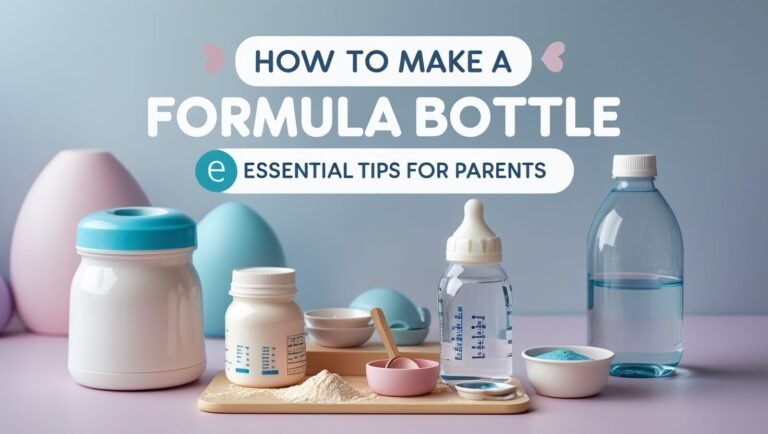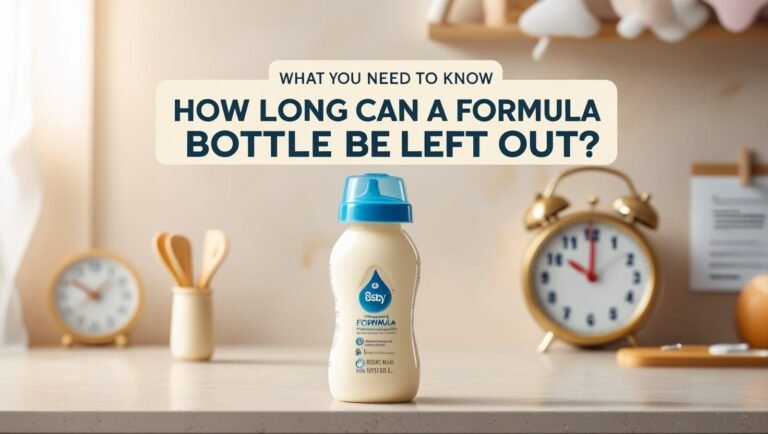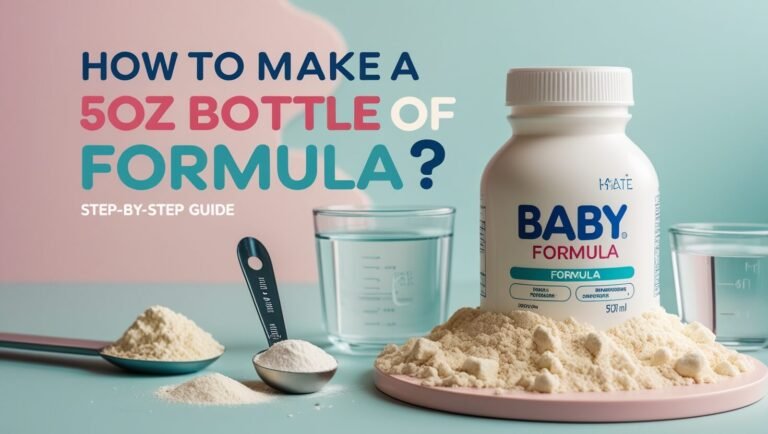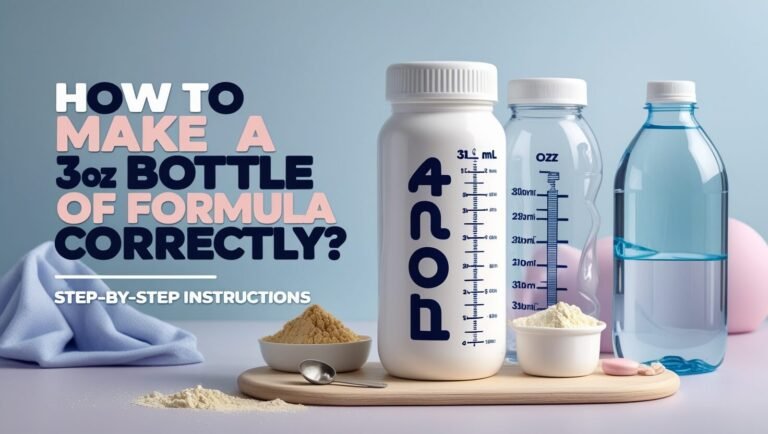How Long Can A Formula Bottle Stay In The Fridge?
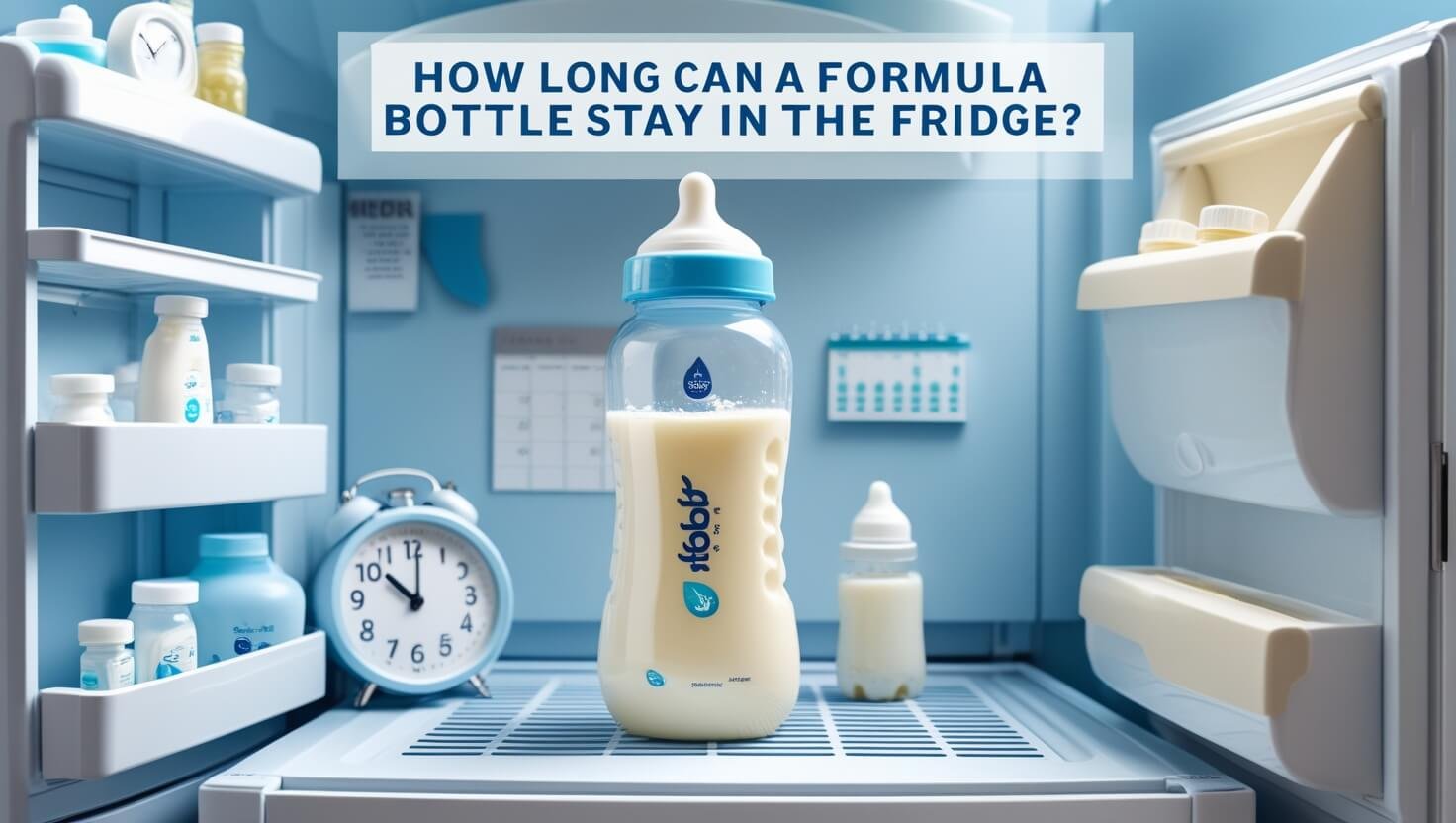
Have you ever thought about how long a formula bottle can stay in the fridge? It’s important to know this to keep your baby safe. The CDC and FDA give tips on how to store formula right. But, it’s key to follow these tips to protect your baby’s health.
It’s important to know how long to store different types of formula in the fridge. Prepared formula can stay in the fridge for 24 hours. But, an open container of ready-to-feed formula should be thrown away after 48 hours if not used. By following these guidelines, you can keep your baby healthy and safe.
Safe Storage Time Limits for Formula Bottles
Storing baby formula safely is key to prevent contamination and spoilage. Keeping formula fresh is vital for the baby’s health. The FDA says prepared formula can stay in the fridge for up to 24 hours. Unopened formula can be stored at room temperature for up to 30 days.
It’s important to follow the formula expiration in fridge guidelines. Here are some key storage time limits to remember:
- Prepared formula: 24 hours in the fridge
- Unopened formula: 30 days at room temperature
- Powder formula: 30 days after opening
- Liquid concentrate and ready-to-feed formulas: 48 hours in the fridge after opening
When storing baby formula, consider the type and its storage needs. Following these guidelines helps keep the formula safe and fresh for your baby.
| Formula Type | Storage Time Limit |
|---|---|
| Prepared Formula | 24 hours in the fridge |
| Unopened Formula | 30 days at room temperature |
| Powder Formula | 30 days after opening |
| Liquid Concentrate and Ready-to-Feed Formulas | 48 hours in the fridge after opening |
How Long Can A Formula Bottle Stay In The Fridge
Keeping your baby’s formula safe is key. Experts say a formula bottle can stay in the fridge for up to 24 hours. But, always check the formula for spoilage before feeding it.
For safe formula bottle storage, use airtight containers and labels. This keeps the formula fresh and prevents contamination. Here are some tips to remember:
- Always check the formula for any signs of spoilage before feeding it to your baby.
- Use airtight containers and labels to store the formula bottle.
- Keep the formula bottle in the fridge at a consistent refrigerated temperature.
Keep your baby safe and healthy by prioritizing safe formula bottle storage and handling to avoid risks.
Temperature Requirements for Safe Storage
Temperature is key when storing formula. It keeps the formula safe and good to use. The fridge should be between 39°F and 41°F for this.
Storing formula right helps it last longer. Use a thermometer to check the fridge’s temperature. Keep it in the coldest spot, like the bottom shelf.
Optimal Fridge Settings
The danger zone is 40°F to 140°F. Bacteria grow fast here. So, keep the formula below 40°F for safety.
Danger Zone Temperatures
Formula should be used quickly. After it’s opened or taken out, use it in 1 hour. This stops bacteria from growing.
Storage Location Within Refrigerator
By following these steps, parents can keep formula safe and fresh. This helps it last longer for their babies.
Signs Your Refrigerated Formula Has Gone Bad
When storing baby formula in the fridge, it’s key to watch for spoilage signs. This is to keep the baby safe. If the formula is not stored right, it can expire. Look out for an off smell, slimy texture, and mold.
Before feeding the baby, always check the formula. Look for mold or an unusual smell. If you see these, throw out the formula and make a new batch.
Here are some tips for storing formula in the fridge:
- Always put the date and time on bottles so you know when 24 hours is up.
- Never save leftovers from a baby’s bottle to avoid bacterial contamination.
- Check the formula for any signs of spoilage before feeding it to the baby.
Watch for expiration to keep the baby safe and healthy. Always check the formula before feeding and throw out any bad formula.
Proper Container Selection and Storage Methods
Choosing the right containers for formula bottle storage is key. Airtight containers and lids prevent contamination and spoilage. This keeps the formula safe and fresh for your baby.
For proper storage, use clean containers and keep them in the fridge at below 5˚C. Discard any leftover formula after 24 hours. Labeling containers with the date and time helps track how long the formula has been stored.
Best Practices for Formula Storage
- Use airtight containers and lids to prevent contamination
- Store formula in the refrigerator at a temperature below 5˚C
- Discard any unused formula after 24 hours
- Label containers with the date and time of preparation
Parents can keep their baby’s formula safe and fresh, ensuring proper care and peace of mind about their nutrition.
| Storage Method | Temperature | Time Limit |
|---|---|---|
| Refrigerator | Below 5˚C | 24 hours |
| Room Temperature | Not recommended | Not recommended |
Common Formula Storage Mistakes
Many parents make mistakes when storing formula, which can harm their baby’s health. The FDA warns that bad storage can lead to contamination and nutrient loss. To keep your baby safe, it’s key to follow the right formula storage guidelines and formula refrigeration tips.
Some common errors include leaving formula out too long, not checking for spoilage, and not using tight containers. You can avoid these by following a few easy steps. For example:
- Refrigerate formula right away if you won’t use it immediately
- Keep it cold until it’s time to feed
- Use it within 24 hours to prevent contamination and nutrient loss
It’s also important to check the formula for spoilage signs like a bad smell or slimy feel. By sticking to these formula storage guidelines and formula refrigeration tips, you can make sure your baby’s formula is safe and healthy.
Remember, the safety and quality of your baby’s formula are of utmost importance. Always prioritize proper storage and handling to give your baby the best possible start in life.
Formula Preparation Tips for Extended Storage
To keep formula safe and quality, it’s key to follow the right steps. Clean handling is vital for keeping formula fresh. This means washing your hands well before making the formula. Also, make sure all tools and surfaces are clean and germ-free.
Mixing the formula right is also important. The way you mix it can affect how long it stays good. Use sterile tools and follow the maker’s mixing guide. This helps avoid contamination and keeps the formula fresh longer.
Clean Handling Practices
Clean handling is more than just washing your hands. It’s also about preparing the formula in a clean spot. Store it in a clean, dry area and use a clean scoop to measure it.
Mixing Techniques
Mixing the formula correctly is key to its shelf life. Follow the maker’s mixing guide and use the right water temperature. Also, mix it well to avoid lumps. These steps help keep the formula fresh and ensure your baby gets the nutrients they need.
Some important tips for making formula include:
- Always use sterile equipment and clean surfaces
- Follow the manufacturer’s instructions for mixing the formula
- Use the recommended water temperature
- Mix the formula thoroughly to prevent lumps or unevenness
These tips help the formula last longer, ensuring your baby gets a safe and nutritious meal.
Safety Protocols for Reheating Stored Formula
Reheating stored formula needs careful steps to avoid contamination and spoilage. It’s important to keep the formula at the right temperature and store it correctly. This helps keep it safe and of good quality.
To safely reheat formula, use a thermometer to check the temperature. Don’t let it get too hot, as this can harm the nutrients and encourage bacteria growth. It’s advised not to heat breastmilk or formula above 104 degrees Fahrenheit (40 degrees Celsius) to preserve nutrients.
Proper Warming Methods
There are safe ways to warm up stored formula. You can:
- Use a bottle warmer or a bowl of warm water to gently heat the formula
- Place the formula bottle in the fridge overnight to let it warm up to room temperature
- Warm the formula in a microwave-safe container, but be careful not to overheat it
Remember to always follow guidelines for storing formula bottles to prevent contamination and spoilage.
Temperature Testing Steps
It’s vital to check the formula’s temperature to ensure it’s safe. Here’s how:
- Use a thermometer to check the formula’s temperature
- Look for any signs of spoilage, like an off smell or slimy texture
- Throw away the formula if it’s been at room temperature for more than two hours
By following these steps and guidelines, parents can make sure their baby’s formula is safe and healthy.
Let’s Complete
The safety and quality of a baby’s formula are very important. By following the guidelines for formula storage, parents can give their baby the best nutrition. It’s key to understand the shelf life of formula bottles and handle them properly.
Unopened formula can last for months. But opened containers need to be refrigerated quickly and used within 24-48 hours. Keeping the formula at the right temperature, preparing it clean, and using it on time is vital. This helps prevent bacteria and keeps the formula nutritious.
With these practices, parents can be sure their baby gets a safe and nourishing formula.

